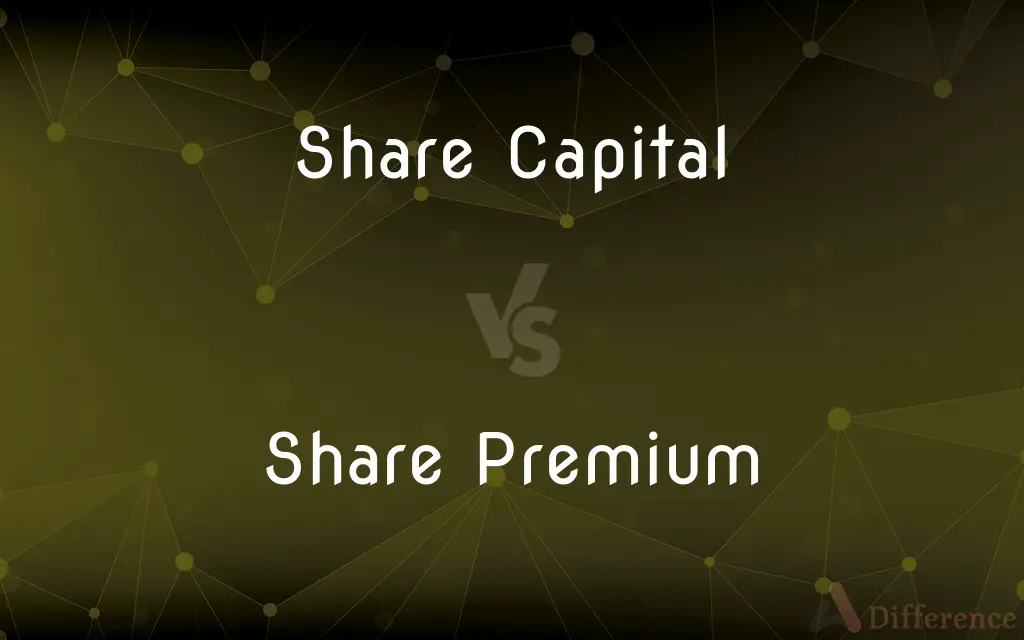Share Capital vs. Share Premium — What's the Difference?
By Tayyaba Rehman — Published on November 27, 2023
Share Capital is the total value of shares issued, while Share Premium is the excess amount received over the par value of shares.

Difference Between Share Capital and Share Premium
Table of Contents
ADVERTISEMENT
Key Differences
Share Capital refers to the funds raised by issuing shares at a nominal or par value. Share Premium, on the other hand, is the extra money obtained by selling shares above their nominal value.
The component known as Share Capital essentially represents the equity base of a company. Share Premium can be considered as a reserve, which is generally not distributable as dividends.
Share Capital reflects the ownership of shareholders in a company. Whereas Share Premium is a sort of additional payment made by investors who have a keen interest in being part of the organization.
In accounting, Share Capital is represented on the balance sheet, indicating the total value of issued shares. In contrast, Share Premium appears under shareholder’s equity but is kept in a separate account.
Share Capital can be utilized for any corporate use; it reflects the shareholder’s total contributions. Share Premium, alternatively, is generally used for specific purposes, such as writing off preliminary expenses.
ADVERTISEMENT
Comparison Chart
Definition
Represents total value of issued shares.
Extra money received over the par value of shares.
Accounting Placement
Shown on the balance sheet.
Appeared under shareholder’s equity.
Usage of Funds
Can be used for various corporate uses.
Typically used for specific purposes.
Impact on Equity
Forms the core part of shareholder’s equity.
Forms a part of reserves within shareholder’s equity.
Relation to Par Value
Issued either at/above/below par value.
Always involves shares issued above par value.
Compare with Definitions
Share Capital
Share Capital is indicative of ownership in the company.
His Share Capital in the business gives him voting rights at the annual meeting.
Share Premium
Share Premium is the amount received over the nominal value of shares.
The Share Premium from the recent share issue was allocated to the reserve.
Share Capital
Share Capital is represented on a company's balance sheet.
The balance sheet clearly displayed an increase in Share Capital after the new issue.
Share Premium
Share Premium can be generated through the issue of either common or preferred shares.
The preferred shares were issued at a substantial Share Premium due to their dividend benefits.
Share Capital
Share Capital can be classified as authorized, issued, subscribed, and paid-up.
The board agreed to increase the authorized Share Capital from $5 million to $10 million.
Share Premium
Share Premium is used for specific purposes, like writing off expenses.
The Share Premium account was utilized to write off the preliminary expenses of the company.
Share Capital
Share Capital is the total value of the company's shares that have been issued.
The company has a Share Capital of $2 million.
Share Premium
Share Premium can't be distributed as dividends.
Management decided to use the Share Premium to offset the underwriting expenses.
Share Capital
Share Capital is a primary source of funds for a company.
They decided to increase the Share Capital to fund the new project.
Share Premium
Share Premium is recorded in the shareholder's equity section, separately from Share Capital.
The balance sheet reflected a substantial Share Premium after the initial public offering.
Common Curiosities
What is Share Capital?
Share Capital is the total value of the shares that a company has issued.
Can Share Capital be used to pay dividends?
Yes, Share Capital represents part of the company's equity and can be used to pay dividends.
How is Share Capital represented in accounting?
Share Capital is represented on the balance sheet under the shareholders' equity section.
What restrictions are placed on the usage of funds obtained via Share Premium?
Share Premium is generally restricted to certain uses like writing off issuance costs or issuing bonus shares, not for dividends.
Can Share Premium be distributed as dividends to shareholders?
No, Share Premium is typically not distributed as dividends and is kept in a separate reserve.
Does higher Share Capital mean higher company value?
Not always. While higher Share Capital indicates more funds have been raised, it doesn’t equate to higher company value directly.
What is the significance of Share Capital in a company's financial structure?
Share Capital signifies the owners' stake in the company, reflecting their risk and reward in the firm's performance.
How is Share Premium generated?
Share Premium is generated when shares are sold above their nominal or par value.
How can a company increase its Share Capital?
A company can increase its Share Capital by issuing new shares through public or private offerings.
Is it possible to have negative Share Capital?
Yes, if a company buys back its shares or has accumulated losses, it might end up with negative Share Capital.
How is Share Premium utilized in a rights issue?
In a rights issue, Share Premium is the excess amount over the face value which investors pay for the new shares.
Does Share Premium indicate the financial health of a company?
Not necessarily, while Share Premium indicates willingness to pay above par by investors, it doesn’t directly denote financial health.
Can a company have Share Premium without having Share Capital?
No, Share Premium is derived from issuing shares, which directly relates to Share Capital, hence cannot exist independently.
Can Share Capital be reduced?
Yes, Share Capital can be reduced through buy-backs or by reducing the par value of shares.
What’s the key difference between Share Capital and Share Premium in accounting?
In accounting, Share Capital is the total value of issued shares, while Share Premium is the amount received over the nominal value of shares.
Share Your Discovery

Previous Comparison
Multimeter vs. Oscilloscope
Next Comparison
Kickoff vs. Kick OffAuthor Spotlight
Written by
Tayyaba RehmanTayyaba Rehman is a distinguished writer, currently serving as a primary contributor to askdifference.com. As a researcher in semantics and etymology, Tayyaba's passion for the complexity of languages and their distinctions has found a perfect home on the platform. Tayyaba delves into the intricacies of language, distinguishing between commonly confused words and phrases, thereby providing clarity for readers worldwide.














































